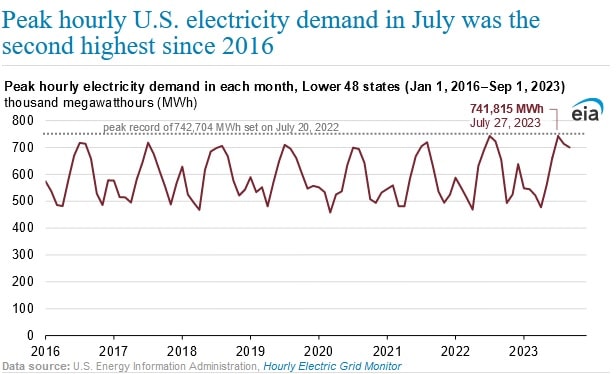Peak Hourly U.S. Electricity Demand Reached New High in July 2023: EIA

U.S. peak hourly electricity demand on July 27, 2023, reached 741,815 megawatt hours (MWh), according to an Oct. 5 report from the U.S. Energy Information Administration. The peak hourly demand was the second highest since 2016 and was marginally below the record high of 742,704 MWh last year on Jul. 20.
U.S. peak electricity demand is predominantly determined by weather, particularly during the summer months, as households and businesses use power for air conditioning. July and August have historically been the months where peak hourly electricity demand surges, due to robust demand for space cooling.
Regional grid limitations remain across the U.S., and this can exacerbate the strain on the electricity grid during periods of high demand. The U.S. power grid functions as three separate electric interconnections (Eastern, Western and Texas) with limited connectivity to one another. As a result, these systems are impacted by region specific weather patterns or asset availability that together create significant differences in the scheduling and magnitude of when demand is highest.
As an example, power demand in Texas hit record highs in late June and July last year, as homes and businesses increased air conditioning, fans, and other cooling equipment to tackle extreme heat waves. Hourly demand on the Texas power grid peaked at 82,579 MWh on July 18, 2022 in the 6:00 p.m. hour central time. Power demand in the Eastern and Western areas were subdued during that period, however because of the lack of interconnection, the excess supply available in those regions was unable to arrive on the Texas electricity grid.
On Sept. 6, the Electric Reliability Council of Texas declared an Energy Emergency Alert (EEA) Stage 2, due to low wind and solar production in the evening and high temperatures. In these instances, the grid operator issues an EEA Stage 2 before they are required to enter alternating outages to ensure grid stability.
The California Independent System Operatorn issued an EEA Stage 1 on July 20, 2023, due to widespread heat. The CAISO relies greatly on imported power from neighbouring regions to help meet demand. In this case, the heat limited the capability of neighbouring grids to split resources, as capacity was required to fulfil demand within their own grids.
EnerKnol Pulses like this one are powered by the EnerKnol Platform—the first comprehensive database for real-time energy policy tracking. Sign up for a free trial below for access to key regulatory data and deep industry insights across the energy spectrum.
ACCESS FREE TRIAL